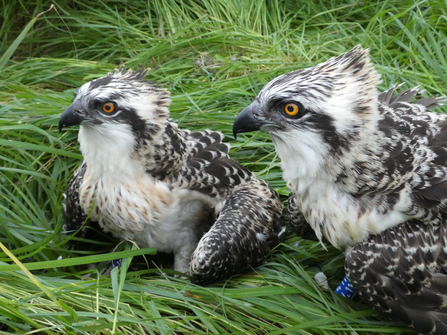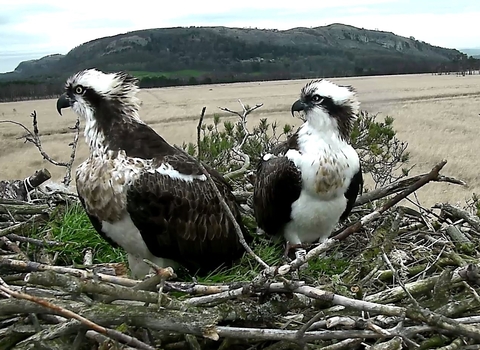
The grant will enable us to invest further in our digital channels, such as our popular webcams

The grant will enable us to invest further in our digital channels, such as our popular webcams
On the evening of Monday 6 July our two osprey chicks at Foulshaw Moss were ringed. It’s not the easiest job to climb a tree and then deal with two rather large birds of prey who’d really prefer not to be removed from their comfy nest. Especially when they’ve just had their tea and are preparing to sleep it off. We’d rather not bother them either, but the knowledge we gain from ringing is so valuable to osprey conservation that the brief disturbance is more than worth it. The whole process takes less than half an hour, but the information the rings provide about their lives and movements keeps coming back for years.
While the chicks were gently lowered to the ground by our trained and licensed climber, mum and dad patrolled the sky above the nest, calling loudly, but not being aggressive. As both of them were ringed as chicks, and their nest has now been visited seven times, they are probably becoming familiar with the routine. At one point one of them relaxed enough to settle in a nearby tree to wait.
When the ringing was over, and the chicks safely back in the nest, dad escorted the ringing party from the premises, flying above them until they were an acceptable distance away. Then, after watching carefully from the nearby perching tree, mum returned to the nest to check on the youngsters. Osprey ringing has been going on in the UK now for over 60 years and, in that time, there has never been an instance of the parents abandoning the nest or the chicks.
Ringing not only allows us to identify the chicks and track their progress, it also gives us a chance to measure, weigh and see what sex they are. This year we have two girls, both weighing in at over 1.8 Kg. This means that, at only six weeks old, they are already bigger than their dad. Female ospreys are usually about 20% bigger than males, so it’s no surprise that they were such a good size, but the larger of the two wasn’t far off 2 Kg, so we think she may have been working out. As fledging approaches in a couple of weeks, they may slow down their eating and lose a little weight in order to take off more easily, but it is good to know that they are so healthy.
Each chick is given two rings. One is a BTO (British Trust for Ornithology) ID ring. It’s made of metal and carries a unique number to identify the bird and a contact address to report it if it’s found. The other ring is bigger and made of coloured plastic with large letters or numbers on it. This means it can be read with a telescope or camera and allows us to recognise the birds from a distance. The characters always read from the foot up to avoid confusion. In 2017 one of our chicks was ringed as N0, which could work either way!
That particular bird turned up this year at an osprey nest in Wales and was picked up on their webcam. We also know that one of our 2014 chicks has bred for the last three years in the Lake District; a 2015 chick visited Kielder, where her mum was born; one of the class of 2016 showed up at Leighton Moss last year; and two of the 2018 brood were sighted holidaying in Spain and The Gambia respectively. This just goes to show how much we can learn from the rings.
In England and Wales the coloured ring goes on the right leg, in Scotland, the left. This means we can very quickly narrow down where a bird is from. All our Foulshaw chicks have had blue leg rings with various combinations of letters and numbers. This year’s chicks are Blue 410 and Blue 411. After they migrate in September, heading on an epic journey to southern Europe or, more likely, West Africa, they will stay away for two to three years. Instinct will then call them back to find a nest of their own and play their part in the amazing recovery that ospreys have made in the last few years. We’ll be looking out for numbers 410 and 411, though to us they will always be Yan and Tan.

Watch the osprey family in their nest at Foulshaw Moss Nature Reserve. They're usually at the nest site between March to early September.